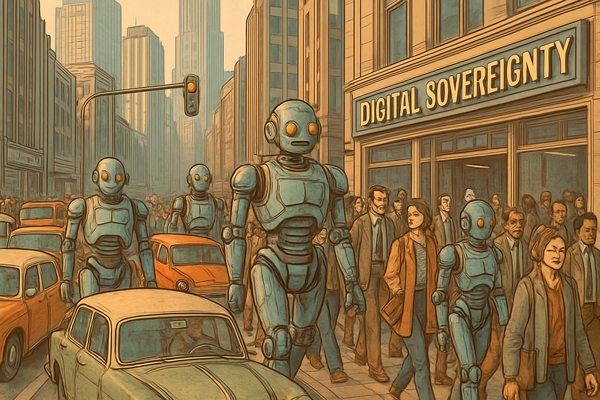Newsletters — Finding Guidance in 35 Lessons From an Experienced Writer
Writing a newsletter can be time consuming and challenging. Am I doing it right, or wrong? Guidance is always welcomed, thanks to experienced writers.


I’ve been writing newsletters for a little more than a year now. Even though I’ve been blogging for more than ten years, I consider myself a newbie in the newsletters space. I’m not sure that I can consider myself successful at it. Depending on how you look at it, maybe yes. I mean, I’ve been writing constantly since the beginning of this adventure. I found my voice. My workflow is clear and effective. I started with HEY World, then moved to Substack before finally moving on to Ghost. I’m still under the hundred subscribers mark. It’s not a lot. I try to imagine that I write to all my friends. We usually don’t have hundreds of real friends, right? Now, I recently came across this interesting post from CJ Chilvers: 35 Lessons from 35 Years of Newsletter Publishing. I love this kind of post. I had a serious look at each lesson and compare it with what I’m doing. I took the original post and commented on each lesson. Here it is.
My first newsletter was about ninjas in 1987. I was 12.
Since then, I’ve been obsessed. I’ve created small newsletters for my own projects, and big newsletters for corporations. What ties them all together? Probably hundreds of things, but I’m lazy, so let’s start with 35.
I won’t lie — most of these lessons here were learned by failure. That’s OK. My mistakes could be your head start.
- Email lasts. You will have a medium that best speaks to your style (maybe audio or video is what keeps you excited), but email is as universal as we’ve gotten online as a species, so far. It’s still the king.
That’s a good one. I’m not good at YouTube and barely better at podcasting (I tried). - There is no competition for your personal voice.
Yeah, I’m unique! Happy to learn that. - Build relationships. That’s what it’s all about. Anyone trying anything else is lying to themselves or their readers. All you need is one relationship to change or save your project, career, or life. Why not establish more? This is also what separates the wealthy from the successful.
How? By allowing comments on each post? By sending email asking for feedback? Or is it with the tone of my writing, trying to sound more like I’m talking to my readers? - Be human. People recognize spam. People recognize a sales pitch. People also recognize honest, direct communication. This is where newsletters excel. Be real. Be vulnerable.
This, I’m good, as I’m using the “Introspection” name in my newsletter because it’s all about reflexion on personal experiences. It’s really something personal. It’s like thinking out loud, but in written form. - The best metric is replies.
I’ve enabled comments on each post. So far, nobody ever commented. Maybe I should add a call for action at the end of each newsletter? Added to my to do. - Perfection sucks and it’s boring.
I must be quite entertaining, then. 😂 - No one cares. You have to give them reasons to care. Earn five seconds of their attention. Then, earn the next five. Repeat.
I have the feeling that the more personal I’m the more attention I’m getting. People love stories about personal experience. - New idea? Just start. You can’t establish relationships if you’re not out there. Whatever it takes, get your idea out there now. Course correct, if and when needed. Every failure is possible entertainment for your audience. So, just ship.
– M’ok. - Curation matters. There’s way too many creators and not enough editors. This scarcity creates value.
That’s the whole point of my monthly newsletter, where I select and comment content in different areas of interest. The personal touch goes into commenting the curated content. - There’s bravery in brevity. Small is considerate, difficult, and valuable. Most books should be a blog post. Most blog posts should be a tweet. Most tweets shouldn’t be.
Trying to shorten it, I guess? - Be consistent. People are creatures of habit. That’s why consistency works. Become a part of their routine.
Oh, yes, I am. Like a clock. Friday Notes post each Friday, one monthly post near the end of each month. Moreover, I may post in the Photo Legend series, once in a while. - Your newsletter is the byproduct of your process. Focus on improving your process and everything else works itself out. This is where you learn how to stay consistent and avoid burn out.
I do care quite a lot about my blogger workflow, actually. - Deliver value, not word counts. Solve someone else’s problem — the bigger the better. It’s nice if it solves your problem too.
This is more in line with my main blog, https://numericcitizen.me. - Don’t be an asshole. Make it easy to unsubscribe. Don’t get bogged down in tracking clicks. Respond. People are not “opens.” People are not “clicks.”
With Ghost, unsubscribing is dumb easy. Maybe too easy, even. There has to be a balance, I guess. 🙃 - Only one person is opening this email. You are not a broadcaster. No one is crowded around a single screen reading your email. You are writing to one, individual reader.
See point #3. I should talk to my readers. - Give a shit. It’s shocking how many don’t.
Judging by the time I spend on this hobby, I do give a shit. I care a lot. I’m doing my best. Every single subscriber counts. - Discovery is recovery. You’ve covered topics a thousand times without realizing they intersect in new and interesting ways. Re-read your stuff, and you’ll find something new every time.
M’ok. The continuous flow of tech news is quite enough and makes it hard for me to keep up. Once published, I move on. - No size fits all. No matter what you do, you won’t please your entire audience. That’s good. Build trust by being honest and you’re bound to get hate. Remember: the opposite of love isn’t hate, it’s indifference.
Gotcha. - Keep track of what delights you about other newsletters — not what engages you (that’s too easy — A.I. can do that). Engagement is good for a few sentences. Delight builds anticipation for the next issue. You’re probably not producing enough delight. You probably should be.
II’m trying, I’ll try harder. - Subject lines don’t matter anywhere near as much as your From line. Trust is the only thing that improves your From line.
M’ok. ‹noreply@numericcitizen-introspection.blog› that is. - Add your newsletter link to all the things. Make it the center of your online universe, because it’s where relationships are built. If you build a newsletter of value, it’s your duty to expose it to as many readers as possible.
I started to make it more often, but I’m shy. I shouldn’t be. I have my Linktr.ee page. ☺️ - Put your best link forward. Value must be made apparent quickly. What gets linked to first, gets clicked on the most — make it valuable enough for the reader to want to return to your newsletter.
I should consider reworking some sections of my monthly newsletter then. Putting my post highlights at the end and starting with my curated sections instead. What do you think? Have a look at this newsletter example. - Cut ruthlessly. In projects and processes: delete first, organize and automate later. Properly-placed automations should occur to you over time and should never come at the cost to the relationship you have with your readers or the quality of the content.
I’m not sure to get this one besides making sure to keep it simple, just the essential content, nothing more. - Your brain doesn’t know the difference between announcing something and shipping it. Announcements are easy, tempting content in newsletters. If you post an announcement, add something to make you accountable to your audience to actually ship (like pre-sales).
Doesn’t apply to me. I guess. - Meet your subscribers. When you meet readers in person, you get a better understanding of how what you do fits in their world. It shapes the way you publish, as well as what you publish.
Well, thanks to COVID-19, it’s not going to happen soon. - Monetization is a byproduct. If you build an audience to serve that audience, monetization will present itself. You don’t need to chase it. You don’t even need to accept it if you don’t want the added responsibility.
I’m not planning of monetizing any of my content. It’s free, now and forever. But you can always support my work. 🙏🏻🥺. - Pick a day, any day. Publish in a manner and at a time that best fits your habits or strategy, not when stats on the general public tells you to. Your audience is not like anyone else’s. You have more control over your publishing schedule than anyone will admit.
Check. Each Friday. At the end of each month. - Ask for testimonials. New readers want to know why they should care about your newsletter. Give them real reasons from real readers.
On my bucket list: having someone write a review of my newsletter. Is this even something possible? - Give more away for free. Nothing is more valuable than the relationships you’re building. Projects come and go, succeed and fail. The audience should remain. What attracts and keeps them is what you’re giving away. You’re probably not giving enough away.
Everything is free. Easy. Next. - Inspiration is scheduled. It’s also called work. The common denominator of our tasks, projects, and entire lives is time. Your schedule is there to keep you consistent and sane. It’s the foundation of your process.
I’m working on my hobby every single day. In the morning. In the evening. Every single day. - Schedule play too. All work and no play makes for a boring newsletter. “Leisure is the basis of culture.” How cultured and interesting can you be if you’re not scheduling time for leisure? Creators don’t want to admit they’re in the entertainment business, but they are. What makes you entertaining? What is entertaining to your audience? How can you make this all a little more fun for everyone?
I’m not good at this. - Create daily. You don’t have to publish daily, but creation is the habit that makes everything else possible.
I do. See point #30. - When stuck, apply another constraint.
I’m rarely stuck. I’m working on many different things. - Celebrate and share the wins of others — always. Be the cheerleader for your topic.
Will do. I follow many newsletters already. - Unlearn. Everything changes. It’s the only constant. Be ready to unlearn in an instant when presented with new information.
My constant curiosity should help me in this respect. It’s probably helping me to craft my lengthy monthly newsletter with new content each month.
That was a long ride. I have the general feeling that I’m on the right track. I’ll keep an eye on these lessons and look for more. If you didn’t know about my newsletter, it’s time to have a look here. Don’t be shy to glance at my content and subscribe, it’s free. It’s super easy to unsubscribe, too. Thanks for stopping by. Your time is precious, I know.



